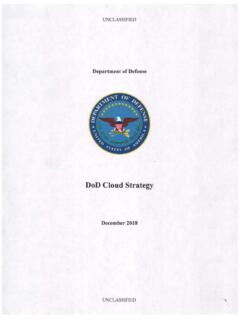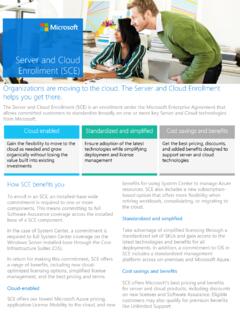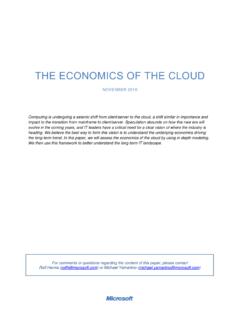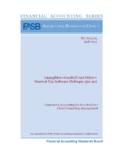Transcription of Practical Guide to Platform as a Service - cloud-council.org
1 Practical Guide to Platform -as-a- Service Version September, 2015. Contents 3. Executive Overview .. 4. PaaS in the Context of cloud Computing .. 4. Characteristics of Platform -as-a- Service .. 10. The Benefits of Platform -as-a- Service .. 12. Examples of PaaS Offerings .. 13. Governance and Business Considerations .. 14. Guide to Acquiring and Using PaaS Offerings .. 16. Understand PaaS end-to-end Application Architecture .. 17. Understand how Containers enable 19. Understand how Services and Microservices are used .. 22. Address Integration between PaaS Applications and existing Systems.
2 23. Ensure appropriate Security components .. 25. Consider Development Tools and PaaS .. 26. Expect support for Agile Development and DevOps .. 27. Consider the Deployment Aspects of PaaS .. 28. Summary of Keys to Success with PaaS .. 29. Works Cited .. 30. Appendix A: Acronyms & Abbreviations .. 31. Copyright 2015 cloud Standards Customer Council Page 2. 2015 cloud Standards Customer Council. All rights reserved. You may download, store, display on your computer, view, print, and link to the Practical Guide to Platform -as-a- Service at the cloud Standards Customer Council Web site subject to the following: (a) the Guidance may be used solely for your personal, informational, non-commercial use; (b) the Guidance may not be modified or altered in any way; (c) the Guidance may not be redistributed; and (d) the trademark, copyright or other notices may not be removed.
3 You may quote portions of the Guidance as permitted by the Fair Use provisions of the United States Copyright Act, provided that you attribute the portions to the cloud Standards Customer Council Practical Guide to Platform -as-a- Service Version (2015). Acknowledgements The major contributors to this whitepaper are: Claude Baudoin (c b IT & Knowledge Management), Michael Behrendt (IBM), Mike Edwards (IBM), Chris Ferris (IBM), Daniel Krook (IBM), John Meegan (IBM), Karolyn Schalk (Garden of The Intellect LLC), Joe Talik (AT&T), Steven Woodward ( cloud Perspectives). Copyright 2015 cloud Standards Customer Council Page 3.
4 Executive Overview The aim of this Guide is to provide a Practical reference to help enterprise information technology (IT). managers, business decision makers, application architects and application developers understand the Platform -as-a- Service (PaaS) cloud Service category and how it can be used to solve business challenges rapidly and cost effectively. The cloud computing marketplace has grown rapidly to encompass a huge range of offerings. PaaS is one of the most dynamic areas of cloud computing, but there is some confusion about the definition of PaaS and the capabilities that should be expected of a PaaS offering.
5 The Practical Guide to Platform -as- a- Service aims to define PaaS and differentiate it from other categories of cloud computing such as Infrastructure-as-a- Service (IaaS) and Software-as-a- Service (SaaS). The capabilities of PaaS systems are discussed and these capabilities have a direct bearing on the types of business problem and kinds of application that are best suited to use PaaS. This Guide recommends best practices for using PaaS in terms of architecture, development processes, integration, deployment and operation. Differences between traditional application development and delivery and the appropriate techniques for PaaS platforms are highlighted, since in many cases the biggest gains for the enterprise result from the adoption of newer, more efficient, more rapid and less error-prone techniques for creating, testing and deploying applications.
6 One challenge that faces cloud Service customers is that many different types of cloud Service are given the label PaaS , so that it can at times be difficult to evaluate what is being offered by the cloud Service provider and even harder to compare offerings from different providers. In this Guide , the aim is to provide customers with an understanding of the range of capabilities that PaaS offerings provide and to distinguish these from what is supplied by IaaS and SaaS cloud services. Inevitably, there are some fuzzy boundaries between the categories of cloud Service and the Guide provides a discussion of these gray areas and how best to evaluate them.
7 The Guide is structured into three main sections: Setting the context for PaaS in cloud services its characteristics and capabilities, the benefits of using PaaS, examples of PaaS offerings and matters of governance and business considerations when using a PaaS offering. Addressing the considerations relating to acquiring and using PaaS cloud services forms the central section of the Guide , examining what types of applications are best suited to PaaS. platforms, the architectural styles involved and the development and operations techniques best used. Finally, providing recommendations on how to best use PaaS services.
8 PaaS in the Context of cloud Computing cloud computing is defined as a paradigm for enabling network access to a scalable and elastic pool of sharable physical and virtual resources with self- Service provisioning and administration on demand [1]. Copyright 2015 cloud Standards Customer Council Page 4. The physical and virtual resources are offered as capabilities by cloud services, invoked through a defined interface. The resources include servers, data storage devices, networks, operating systems, software and applications. cloud computing offers almost all of the capabilities of IT systems through cloud services that are invoked across the network and it is the sheer breadth of capabilities that can be a challenge for the cloud Service customer to understand.
9 The ISO/IEC cloud computing standards [1] [2] divide the capabilities offered by cloud services into 3 broad groups: Infrastructure capabilities, where the cloud Service customer can provision and use processing, storage and network resources. Platform capabilities, where the cloud Service customer can develop, deploy, manage and run applications (created by the customer or acquired from a third party) using one or more execution environments supported by the cloud Service provider. Application capabilities, where the cloud Service customer can use one or more applications supplied by the cloud Service provider.
10 Unsurprisingly, PaaS concerns the provision of Platform capabilities, but for better understanding it is worthwhile to examine all three groups of cloud services and also the traditional approach of deploying applications in on-premises datacenters, as shown in Figure 1. Figure 1: Application deployment - traditional and cloud -based Copyright 2015 cloud Standards Customer Council Page 5. It is important to note the focus on applications in this discussion. PaaS is primarily concerned with developing, deploying and operating customer applications other capabilities may be involved, such as the use of processing, storage and network resources, but they are not the main focus.







